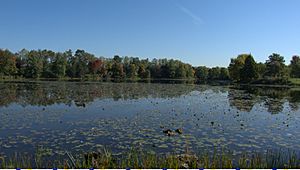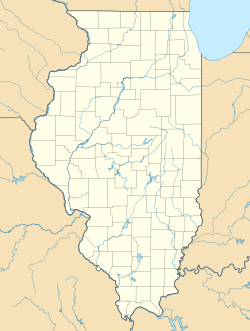Palos Hills, Illinois facts for kids
Quick facts for kids
Palos Hills, Illinois
|
||
|---|---|---|

Park in Palos Hills, Illinois
|
||
|
||
| Motto(s):
"Pride In Progress"
|
||

Location of Palos Hills in Cook County, Illinois.
|
||
| Country | United States | |
| State | Illinois | |
| County | Cook | |
| Township | Palos | |
| Incorporated | 1958 | |
| Government | ||
| • Type | Mayor–council | |
| Area | ||
| • Total | 4.29 sq mi (11.11 km2) | |
| • Land | 4.25 sq mi (11.00 km2) | |
| • Water | 0.04 sq mi (0.11 km2) 0.93% | |
| Population
(2020)
|
||
| • Total | 18,530 | |
| • Density | 4,364.11/sq mi (1,684.87/km2) | |
| Standard of living (2007-11) | ||
| • Per capita income | $29,783 | |
| • Median home value | $223,200 | |
| ZIP code(s) |
60465
|
|
| Area code(s) | 708 | |
| Geocode | 57394 | |
| FIPS code | 17-57394 | |
Palos Hills is a city located in Cook County, Illinois, United States. It's a suburb found southwest of Chicago. The city was officially started in 1958. In the 2020 census, about 18,530 people lived there.
Palos Hills gets its name from Palos de la Frontera, a town in Spain. This Spanish town is famous because Christopher Columbus started his journey to North America from there. Important schools in Palos Hills include Moraine Valley Community College and Amos Alonzo Stagg High School.
Contents
Where is Palos Hills? (Geography)
Palos Hills covers a total area of about 4.29 square miles (11.11 square kilometers). Most of this area, about 4.25 square miles (11.00 square kilometers), is land. A small part, about 0.04 square miles (0.11 square kilometers), is water.
Who Lives in Palos Hills? (Demographics)
The number of people living in Palos Hills has changed over the years:
| Historical population | |||
|---|---|---|---|
| Census | Pop. | %± | |
| 1960 | 3,766 | — | |
| 1970 | 6,629 | 76.0% | |
| 1980 | 16,654 | 151.2% | |
| 1990 | 17,803 | 6.9% | |
| 2000 | 17,665 | −0.8% | |
| 2010 | 17,484 | −1.0% | |
| 2020 | 18,530 | 6.0% | |
| U.S. Decennial Census 2010 2020 |
|||
In 2020, there were 18,530 people living in Palos Hills. There were 7,247 households, which are groups of people living together in one home.
Most people in the city are White (about 81.70%). There are also people who are African American (5.77%), Asian (2.17%), and from other backgrounds. About 10.19% of the population is Hispanic or Latino.
Many residents have family roots from different countries. The most common backgrounds reported in 2020 were Polish (29.3%), German (12.7%), Irish (12.6%), Arab (9.6%), and Italian (8.3%).
About 22.4% of households had children under 18 living with them. Many homes (43.63%) were married couples. About 17.01% of households had someone aged 65 or older living alone.
The average age of people in Palos Hills was 44.6 years. About 18.1% of the population was under 18 years old.
The average income for a household in the city was about $64,364. For families, the average income was $81,045. About 12.0% of all people in Palos Hills lived below the poverty line. This included 15.1% of those under 18.
| Race / Ethnicity (NH = Non-Hispanic) | Pop 2000 | Pop 2010 | Pop 2020 | % 2000 | % 2010 | % 2020 |
|---|---|---|---|---|---|---|
| White alone (NH) | 14,897 | 14,591 | 14,729 | 84.33% | 83.45% | 79.49% |
| Black or African American alone (NH) | 960 | 926 | 1,040 | 5.43% | 5.30% | 5.61% |
| Native American or Alaska Native alone (NH) | 12 | 14 | 9 | 0.07% | 0.08% | 0.05% |
| Asian alone (NH) | 468 | 450 | 392 | 2.65% | 2.57% | 2.12% |
| Pacific Islander alone (NH) | 2 | 4 | 0 | 0.01% | 0.02% | 0.00% |
| Other race alone (NH) | 19 | 14 | 85 | 0.11% | 0.00% | 0.46% |
| Mixed race or Multiracial (NH) | 453 | 193 | 386 | 2.56% | 1.10% | 2.08% |
| Hispanic or Latino (any race) | 854 | 1,292 | 1,889 | 4.83% | 7.39% | 10.19% |
| Total | 17,665 | 17,484 | 18,530 | 100.00% | 100.00% | 100.00% |
Schools in Palos Hills
Students in Palos Hills attend schools in several different districts.
Elementary Schools
- North Palos School District 117
- Palos School District 118
- All parts of Palos Hills in District 118 are zoned to Palos South Middle School. This school is located in Palos Park.
- Before 2016-2017, all students in District 118 from Palos Hills went to Palos East Elementary. Now, sections are split between Palos East Elementary in Palos Heights and Palos West Elementary in Palos Park.
High School
- Amos Alonzo Stagg High School serves students from Palos Hills. It is part of the Consolidated High School District 230.
Community College
- Moraine Valley Community College is the local college for the area.
Getting Around Palos Hills (Transportation)
Pace provides bus services in Palos Hills. These buses connect the city to many other places in the Southland region.
Famous People from Palos Hills
Some notable people who have lived in Palos Hills include:
- Nick Drnaso, a cartoonist
- Christian Dvorak, a professional ice hockey player
- Matthew Haag, a professional gamer
- T. J. McFarland, a professional baseball pitcher
- Herb Schumann, a former Cook County commissioner
- Ben Skora, an inventor
See also
In Spanish: Palos Hills (Illinois) para niños





